Related Research Articles

A torc, also spelled torq or torque, is a large rigid or stiff neck ring in metal, made either as a single piece or from strands twisted together. The great majority are open at the front, although some have hook and ring closures and a few have mortice and tenon locking catches to close them. Many seem designed for near-permanent wear and would have been difficult to remove.
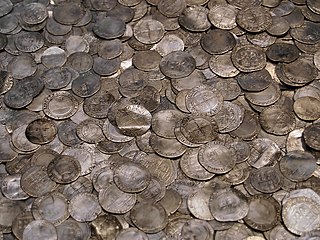
A hoard or "wealth deposit" is an archaeological term for a collection of valuable objects or artifacts, sometimes purposely buried in the ground, in which case it is sometimes also known as a cache. This would usually be with the intention of later recovery by the hoarder; hoarders sometimes died or were unable to return for other reasons before retrieving the hoard, and these surviving hoards might then be uncovered much later by metal detector hobbyists, members of the public, and archaeologists.

The Hoxne Hoard is the largest hoard of late Roman silver and gold discovered in Britain, and the largest collection of gold and silver coins of the fourth and fifth centuries found anywhere within the former Roman Empire. It was found by Eric Lawes, a metal detectorist in the village of Hoxne in Suffolk, England in 1992. The hoard consists of 14,865 Roman gold, silver, and bronze coins and approximately 200 items of silver tableware and gold jewellery. The objects are now in the British Museum in London, where the most important pieces and a selection of the rest are on permanent display. In 1993, the Treasure Valuation Committee valued the hoard at £1.75 million.

The Dacian bracelets are bracelets associated with the ancient people known as the Dacians, a distinct branch of the Thracians. These bracelets were used as ornaments, currency, high rank insignia and votive offerings Their ornamentations consist of many elaborate regionally distinct styles. Bracelets of various types were worn by Dacians, but the most characteristic piece of their jewelry was the large multi-spiral bracelets; engraved with palmettes towards the ends and terminating in the shape of an animal head, usually that of a snake.

The Staffordshire Hoard is the largest hoard of Anglo-Saxon gold and silver metalwork yet found. It consists of almost 4,600 items and metal fragments, amounting to a total of 5.1 kg (11 lb) of gold, 1.4 kg (3 lb) of silver and some 3,500 pieces of garnet cloisonné jewellery. It is described by the historian Cat Jarman as "possibly the finest collection of early medieval artefacts ever discovered".

The Milton Keynes Hoard is a hoard of Bronze Age gold found in September 2000 in a field at Monkston Park in Milton Keynes, England. The hoard consisted of two torcs, three bracelets, and a fragment of bronze rod contained in a pottery vessel. The inclusion of pottery in the find enabled it to be dated to around 1150–800 BC.

Saka is a village in Toila Parish, Ida-Viru County in northeastern Estonia. Before the 2017 Administrative Reform, the village belonged to Kohtla Parish. Karjaoru Falls is located in Saka.

The Wulfing cache, or Malden plates, are eight Mississippian copper plates crafted by peoples of the Mississippian culture. They were discovered in Dunklin County, Missouri in 1906 by Ray Grooms, a farmer, while plowing a field south of Malden. The repousséd copper plates were instrumental to archaeologists' developing the concept known as the Southeastern Ceremonial Complex.

The Vinkovci Treasure or Cibalae Treasure is a hoard of late Roman silver plate, discovered in Vinkovci, Croatia at the end of March 2012. Consisting of 48 artifacts weighing a total of about 36 kilograms (79 lb), the hoard includes a variety of domestic utensils and tableware, some of which is elaborately decorated with various designs and depictions. The hoard appears to have been made locally, probably in a workshop in the town, and is thought to date to the late 4th century AD. Following its discovery during construction works in the centre of Vinkovci, it was put on public display in Vinkovci and at the Museum of Arts and Crafts in Zagreb prior to a programme of conservation funded by the Croatian government.
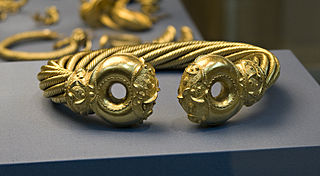
The Great Torc from Snettisham or Snettisham Great Torc is a large Iron Age torc or neck ring in electrum, from the 1st century BC. It is one of the finest pieces of early Celtic art in a distinctly British Celtic style. It is the most spectacular object in the Snettisham Hoard of torcs and other metalwork found in 1950 near the village of Snettisham in Norfolk, East Anglia. The perfectly intact torc is noted for its high level of craftsmanship and artistry. Soon after its discovery it was acquired by the British Museum.
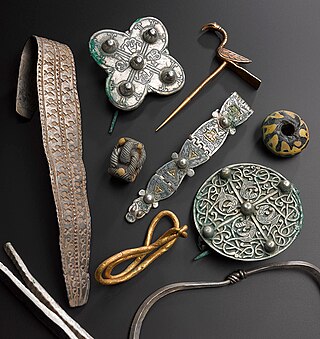
The Galloway Hoard, currently held in the National Museum of Scotland, is a hoard of more than 100 gold, silver, glass, crystal, stone, and earthen objects from the Viking Age discovered in the historical county of Kirkcudbrightshire in Dumfries and Galloway in Scotland in September 2014. Found on Church of Scotland land, the hoard has been described by experts as "one of the most significant Viking hoards ever found in Scotland". With years of extensive study and research, scholars are still not certain who buried the hoard, why they did so and whether they were Vikings or Anglo-Saxons. During the Viking Age, Galloway found itself squeezed between two Viking kingdoms and essentially cut off from other Anglo-Saxons in Britain - "Galloway is where these different cultures were meeting. It’s not just Scandinavians, but people from Britain and Ireland as well."

The Bedale Hoard is a hoard of forty-eight silver and gold items dating from the late 9th to early 10th centuries AD and includes necklaces, arm-bands, a sword pommel, hacksilver and ingots. It was discovered on 22 May 2012 in a field near Bedale, North Yorkshire, by metal detectorists, and reported via the Portable Antiquities Scheme. Following a successful public funding campaign, the hoard was acquired by the Yorkshire Museum for £50,000.
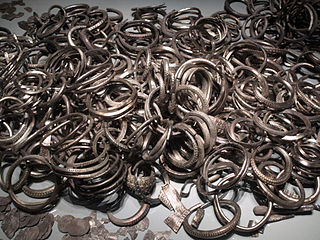
The Spillings Hoard is the world's largest Viking silver treasure, found on Friday 16 July 1999 in a field at the Spilling farm northwest of Slite, on northern Gotland, Sweden. The silver hoard consisted of two parts with a total weight of 67 kg (148 lb) before conservation and consisted of, among other things, 14,295 coins most of which were Islamic from other countries. A third deposition containing over 20 kg (44 lb) of bronze scrap-metal was also found. The three caches had been hidden under the floorboards of a Viking outhouse sometime during the 9th century.

The so-called Lithuanian long currency was a type of money used by the Baltic tribes and in the early Grand Duchy of Lithuania in the 12th–15th centuries. It was commodity money in the form of silver ingots. Most often they were semicircular rods about 13 cm (5.1 in) in length and weighted between 100 and 110 g. Other trading centers, notably Kievan Rus' and Veliky Novgorod, developed their own version of such ingots which are known as grivna or grzywna. The ingots were replaced by minted coins in the middle of the 15th century.

The Curmsun Disc is a convex-concave gold disc that gained scholarly attention in 2014 after an 11-year-old Polish girl in Sweden showed it to her history teacher. Some scholars have tentatively dated the disc to the 10th to 12th century, although its authenticity is not universally accepted by historians or archaeologists.
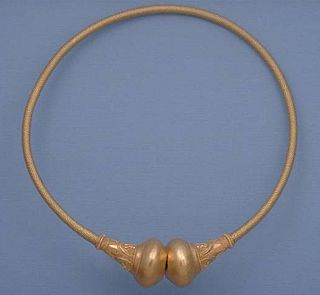
The Havor hoard is an Iron Age treasure found in 1961, in Hablingbo on the Swedish island of Gotland. It consists of a large gold torc, known as the Havor Ring, along with several well-preserved bronze objects and was buried inside a Roman bronze situla in the mound surrounding a hillfort.

The Sundveda Hoard is a Viking Age hoard of 482 silver coins found in 2008 in Sundveda between Märsta and Sigtuna, not far from Stockholm in Sweden. It is the largest silver hoard found in the Mälaren region since 1827.
Molnby Hoard is a Viking Age deposit of 163 silver coins found in Molnby, Vallentuna Municipality in Sweden in October 2016. Most of the coins come from the area around Samarkand in Central Asia and date from the 10th century. The hoard is one of the largest Viking Age hoards to have been discovered in the province of Uppland.
The Ubina Hoard is a wealth deposit of silver coins and jewelry found in the village of Salu, Harju County in Estonia in 2005. The oldest items in the hoard probably date from the Viking Age but the hoard seems to have been deposited during the beginning of the 12th century. The archaeological site was subjected to looting the day after its discovery, but coins and jewelry fragments later surfaced in Germany and led to successful legal prosecution of the looter and the return of the looted items to the authorities.

The Leekfrith torcs are four Iron Age gold torcs found by two hobby metal detectorists in December 2016 in a field in Leekfrith, north Staffordshire, England. The find consists of three neck torcs and a smaller bracelet, which were located in proximity to each other. They are believed to be the oldest Iron Age gold jewellery found in Britain. Subsequent archaeological examination of the area did not uncover further objects.
References
- ↑ Tamla, Ülle (2015). "Saka Late Viking Age silver hoard from north-east Estonia". Archaeological Fieldwork in Estonia: 113–120. Retrieved 11 February 2017.